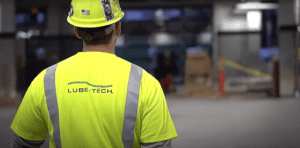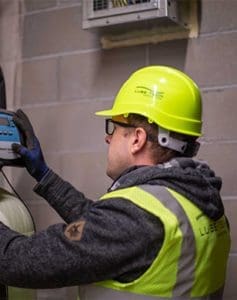 At Lube-Tech, we operate under five core values and first among them is “We Work Safely.” Whether it’s those working within our facilities, Lube-Tech employees in the field, and any of our customers who are working with Lube-Tech products or equipment, we do everything we can to keep each other safe and make sure every one of us goes home safely each day.
At Lube-Tech, we operate under five core values and first among them is “We Work Safely.” Whether it’s those working within our facilities, Lube-Tech employees in the field, and any of our customers who are working with Lube-Tech products or equipment, we do everything we can to keep each other safe and make sure every one of us goes home safely each day.
Our, Safety, Security and Environment (SSE) team is constantly working to make our facilities, and any places our teammates work, safer. As safety incidents are reported, we investigate and take the steps necessary to ensure the safety of teammates and visitors.
For example, recently a delivery driver was filling a tank at a customer site in Wisconsin. Oftentimes, tanks have sight tubes and overfill protection equipment installed to prevent accidental spills. In this case, that equipment was not installed and the delivery rep thought there was more room in the tank than there was. The result was a fluid spill onto the ground that the rep quickly cleaned up and notified management and the SSE team.
We are now working with the customer to install a sight tube and overfill protection to prevent a similar accident to occur again. We recommend that all tanks have these protective measures installed. If you have tanks without sight tubes and overfill protection, contact us or reach out to your representative to discuss an installation plan.
However, we don’t want to be just reactionary to incidents, but rather, anticipate potential safety issues before they occur. It’s the difference between hindsight and foresight. Yes, it is important to make corrections after an event. More importantly, though, is to see potential issues before they happen and prevent them from happening in the first place.
We had a recent event at our Golden Valley warehouse involving a forklift removing a pallet of materials from the rack. In this case, we anticipated potential consequences and took steps to prevent an accident.
While a forklift operator was moving a pallet from the racking, a neighboring pallet rolled forward causing the 55-gallon drums on the pallet to slide about five or six inches and could have easily fallen to the ground or on to the forklift driver. Fortunately, our safety measures call for banding tape, which held the barrels together and prevented them from falling. If we had used a weaker material than the banding tape, or no wrapping at all, we may have had an environmental spill or, worse, an injured employee.
If you have materials on racks, it’s important to look at what could happen. Now is a perfect time to evaluate how you store supplies or products and determine if you are doing it safely. Nobody wants injuries or fatalities; or even close calls. It’s never too early or too late to ensure you have the best working conditions for your employees or have a strong safety culture in your organization.
 As part of our process to eliminate, or, at the very least, minimize events, we’re looking closely at incidents that don’t result in a serious or fatal injury but have the potential to do so if circumstances were different. These types of incidents are commonly referred to as Near Misses. All Near Miss incidents are important, but we pay special attention to those that are considered Potential Serious Injury or Fatality (PSIF) or Potential Serious Environmental Incidents (PSEI). To help understand the potential seriousness of a safety-related incident we study the consequences and probabilities related to an incident.
As part of our process to eliminate, or, at the very least, minimize events, we’re looking closely at incidents that don’t result in a serious or fatal injury but have the potential to do so if circumstances were different. These types of incidents are commonly referred to as Near Misses. All Near Miss incidents are important, but we pay special attention to those that are considered Potential Serious Injury or Fatality (PSIF) or Potential Serious Environmental Incidents (PSEI). To help understand the potential seriousness of a safety-related incident we study the consequences and probabilities related to an incident.
Consequences
Consequences refers to what is the realistic worst-case potential outcome of a PSIF/PSEI. It looks at an event to see if it is minor in nature, like a first aid or minimal damage, or more catastrophic, like a fatality or uncontrolled spill to the environment that impacts our waterways.
Probabilities
Probability is how likely the potential consequence is to occur again if nothing is done to correct the situation (i.e. corrective/preventive actions). It ranges from unlikely that the potential consequence would happen again to a certainty that it will happen again.
If a safety incident occurs, we track the potential consequences and the probability, placing it in a Risk Grid. Events with a high probability and greater chance of serious consequences get a higher level of investigation and response to do everything we can to lower the probability or the potential consequences.
If you have questions about safety procedures, how to keep your employees and visitors safe, or our method for tracking events, we encourage you to contact us.
